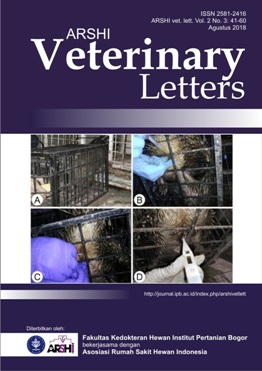Isolasi Brucella abortus dari cairan higroma dan susu
Abstract
Brucella abortus merupakan salah satu bakteri penyebab keguguran pada ternak sapi. Sampel cairan higroma dan susu digunakan untuk screening keberadaan bakteri B. abortus dari ternak yang dicurigai menderita brucellosis. Tujuan dari penelitian ini adalah untuk memperoleh bakteri B. abortus dari sampel cairan higroma dan susu. Total 36 sampel cairan higroma dan susu diperoleh dari NTT dan Jawa barat. Sampel ditumbuhkan dalam media TSB dan TSA dengan CO2 5 %. Hasil pemeriksaan menunjukkan morfologi koloni bakteri bulat, halus dan permukaan convex, hasil pewarnaan Gram menunjukkan bakteri gram negatif, coccobacillus dan memiliki kecenderungan sendiri-sendiri ataupun berpasangan. Uji biokimiawi katalase dan oksidase menunjukkan hasil positif, sedangkan uji sitrat negatif. Bakteri memerlukan penambahan 5% CO2 dalam pertumbuhannya, memiliki kemampuan memproduksi H2S, dan urease serta tumbuh dengan keberadaan Basic Fuchin, tetapi tidak tumbuh di zat warna Thionin. Bakteri yang tumbuh tersebut diidentifikasi sebagai B. abortus.Total isolat B. abortus yang diperoleh pada penelitian ini adalah 16 isolat dari 36 sampel cairan higroma dan susu.Downloads
References
Alton GG, Jones LM, Angus RD, Vengr JM. 1988. Techniques for The Brucellosis Laboratory. Paris: Institute National De La Re-cherche Agronomique.
Chisi SL, Marageni Y, Naidoo P, Zulu G, Akol GW, Van Heerden H. 2017. An evaluation of serological tests in the diagnosis of bovine brucellosis in naturally infected cattle in KwaZulu-Natal province in South Africa. J S Afr Vet Assoc. 88(1): 1-7.
Denis RM, Shaman M, Sofia B, Joseph E, George WN, Charles W, Gerald M, Markus K, Ulf Magnusson. 2015. Isolation and mo-lecular characterization of brucella isolates in cattle milk in Uganda. BioMed Research International. 2015:1-9.
Dereje T, Benti D, Feyisa B, Abiy G. 2018. Review of common causes of abortion in dairy cattle in Ethiopia. J Vet Med Anim Health. 10(1): 1-13.
Jennifer AZ, Maves RC, Nydam DV, Ayvar V, Cepeda D, Castillo R, Diaz-Pino A, Saito M, Gilman RH. 2012. Effect of storage temperature and sample volume on Brucella melitensis isolation from goat milk. Int J Tropical Dis Health. 2012: 207-213.
Kirit BP, HC Chauhan, BK Patel, SS Patel, MD Shrimali, JK Kala, SI Patel, AN Modi, AC Patel, Manish Rajgor, MA Patel, MG Patel, BS Chandel. 2017. Isolation, identification and molecular detection of Brucella abortus from buffaloes in Gujarat, India. Int J Curr Microbiol App Sci. 6(4): 1787-1795.
Lake, PRMT. 2010. Kajian Lintas Seksional Brucellosis pada Sapi di Kabupaten Belu. Tesis. Universitas Gadjah Mada.
Mathew C, M Stokstad, TB Johansen, S Klevar, RH Mdegela, G Mwamengele, P Michel, L Escobar, D Fretin, J Godfroid. 2015. First isolation, identification, phenotypic and genotypic charac-terization of Brucella abortus biovar 3 from dairy cattle in Tan-zania. BMC Veterinary Research. 11(1):156.
Md. Sadequl I, Md. Ariful I, Mst. Minara K, Sukumar S, Md. Samiul B, Md. Mahmodul H. 2018. Molecular detection of Brucella spp. from milk of seronegative cows from some select-ed Aaea in Bangladesh. Journal of Pathogens 2018:1-7.
OIE. World Organization for Animal Health. 2016. Terrestrial Mannual. Chapter 2.1.4. Brucellosis. www.oie.int.
Quinn PJ, BK Markey, ME Carter, WJ Donnelly, FC Leonard. 2002. Veterinary Microbiology and Microbial Disease. Black-well publishing. 162-167.
Sanogo M, Abatih, Eric Thys , Fretin D, Berkvens D, Saegerman C. 2013. Importance of identification and typing of brucella from west African cattle: A review. Veterinary Microbiology 164(3-4): 202–211.
Copyright (c) 2018 CC-BY-SA

This work is licensed under a Creative Commons Attribution-ShareAlike 4.0 International License.
Authors who publish with this journal agree to the following terms:
1. Authors retain copyright and grant the journal right of first publication with the work simultaneously licensed under a Creative Commons Attribution License that allows others to share the work with an acknowledgement of the work's authorship and initial publication in this journal.
2. Authors are able to enter into separate, additional contractual arrangements for the non-exclusive distribution of the journal's published version of the work (e.g., post it to an institutional repository or publish it in a book), with an acknowledgement of its initial publication in this journal.
3. Authors are permitted and encouraged to post their work online (e.g., in institutional repositories or on their website) prior to and during the submission process, as it can lead to productive exchanges, as well as earlier and greater citation of published work (See The Effect of Open Access).


.jpg)















